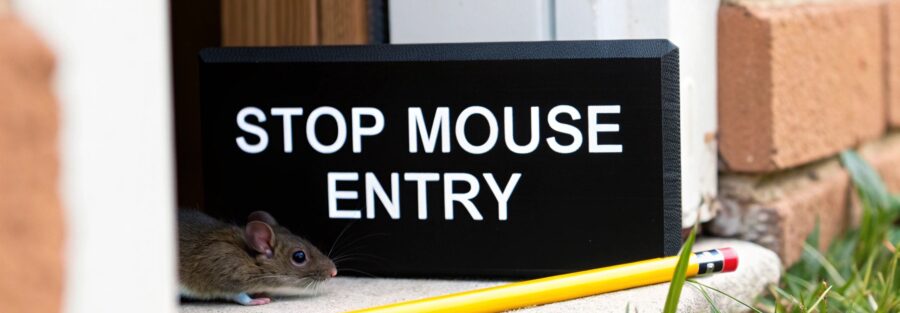It’s a question we get asked all the time: how on earth did a mouse get into my house? The answer is both simple and a little unnerving. They aren't chewing through solid brickwork; they're exploiting tiny, pre-existing gaps you probably never even noticed.
Think of them as nature's little opportunists. With a surprisingly flexible skeleton, a mouse can flatten its body and squeeze through an opening no wider than a pencil. This instinct to find food, warmth, and shelter kicks into high gear during the colder UK seasons, making our homes the perfect target.
The Surprising Ways Mice Enter Your Home
Mice aren't master criminals planning a complex heist. They're just following their powerful survival instincts, which means finding a safe harbour away from the elements and predators. Your home, with its steady temperature and endless supply of crumbs, is a five-star hotel from their perspective.
Their hunt for a way in is relentless. A mouse can squeeze its body to an astonishing degree, turning the slightest crack into an open door. For older UK properties, this is a huge factor. Experts know that mice can get through holes as small as 6mm – that’s tiny! Ageing pipes, forgotten vents, and small cracks in the foundation become superhighways for these unwanted guests.
Common Mouse Entry Points at a Glance
To really mouse-proof your home, you need to start thinking like a mouse. Every little imperfection is a potential entrance.
We’ve put together a quick summary of the most common entry points we find in UK homes. If you want to dive deeper, check out our full guide on how mice get into your house.
| Entry Point Category | Specific Examples | Why It's a Weakness |
|---|---|---|
| Foundation & Walls | Cracks in concrete, gaps around utility pipes (gas, water), weep holes in brickwork. | These provide direct, ground-level access into wall cavities and basements. |
| Doors & Windows | Worn weather stripping, gaps under garage doors, poorly sealed window frames. | Even a tiny gap at the bottom of a door is an open invitation for a mouse. |
| Roof & Vents | Uncovered attic vents, gaps in eaves or soffits, holes around chimney flashing. | Mice are excellent climbers and can easily access these higher entry points. |
By spotting these common weak points, you can start building an effective defence. It's all about turning your home from an easy target into a secure fortress.
Thinking Like a Mouse: Why Your Home is Their Target

To really stop mice, you first have to understand why they want to get into your home in the first place. It’s not a random choice. Powerful, primal instincts are driving them indoors, and from their point of view, your house is the ultimate prize: a warm sanctuary, packed with food, and safe from the dangers outside.
Think about it from their perspective. A mouse's world is dominated by smell. Their sense of smell is incredibly sensitive, meaning they can detect the faintest whiff of food from a surprisingly long way away. That single biscuit crumb you missed under the sofa, or the dog's food left out overnight? To a mouse, that’s a flashing neon sign advertising a reliable meal.
The Primal Need for Shelter and Warmth
But it's not just about food. Mice are on a constant search for secure, warm spots to build nests and raise their young. Your home is basically a five-star hotel, offering stable temperatures and countless perfect hiding spots. Wall cavities, loft insulation, and the dark, undisturbed corners behind kitchen appliances provide the exact conditions they need to thrive, especially during the UK's cold and wet months.
A mouse’s goals are incredibly simple: find food, find shelter, and avoid predators. Your home solves all three problems at once, making it a high-value target they will work tirelessly to get into.
This relentless search for safety means they will meticulously explore every inch of your home's exterior. They aren't just wandering about; they are actively probing for any weakness or vulnerability that could grant them access to this perfect new environment.
Following the Path of Least Resistance
One of the most important things to understand about mouse behaviour is a concept called thigmotaxis. This is just a technical term for their instinct to move along walls and other vertical surfaces. They feel much safer when their bodies are touching a solid object, using it as a guide to navigate. It's exactly why you almost always find droppings and gnaw marks along skirting boards.
This instinct is critical to how they find their way inside. By hugging the foundation of your property, they will eventually discover every tiny crack, unsealed pipe, or gap under a door.
- Sense of Touch: Their whiskers and bodies give them constant feedback, helping them map out routes and pinpoint small openings you’d never notice.
- Perimeter Patrol: They methodically patrol the edges of buildings, testing every single potential entry point along the way.
- Memory and Navigation: Once a mouse finds a safe route inside, it remembers it. It will use that path over and over, creating a hidden "motorway" into your home for itself and others.
Once you realise that mice aren't just random intruders but are actually strategic survivalists, you can start to see your home through their eyes. Every unsealed gap is a doorway, and every crumb is a welcome mat. This shift in perspective is the first, most crucial step toward creating a truly mouse-proof home.
Finding Your Home's Weak Spots

Every home has them, no matter how new or well-built. I’m talking about weak spots – the little vulnerabilities a determined mouse can and will exploit. Spotting these is the first real step to fortifying your property. Think of it like a security audit; you’re searching for the unlocked doors and open windows that mice see as a glowing invitation.
These entry points are often so subtle you’d walk past them every day without a second thought. A tiny crack in the foundation, a small gap where a pipe enters the wall, or a worn-out seal on the garage door might seem trivial to us. To a mouse, it’s a superhighway right into your home.
Ground-Level Intruders
Most of the time, mice get in at ground level. This is where your property is most exposed, with countless potential entry points created by construction, age, and simple wear and tear. A systematic check of your home's perimeter is absolutely essential.
Start by getting up close and personal with your foundation. Look for any cracks, however small. Pay special attention to where utility lines for gas, water, and electricity enter the building. Builders often drill holes far larger than the pipes themselves, and the sealant they use can degrade over time, leaving a perfect, ready-made entryway.
Pest control data shows that UK mice are primarily driven indoors by the hunt for food, warmth, and shelter, especially in the colder months. Infestation rates often spike in areas with older housing stock, where deteriorated foundations and gaps around plumbing are common. You can explore more insights on UK pest trends from the Independent.
Another classic weak spot people miss? Weep holes. These small gaps are deliberately left in brickwork to let moisture escape, but if they don’t have a proper guard, they offer a direct route into your wall cavities.
Common Ground-Floor Vulnerabilities
Here are the key areas to inspect around the base of your home:
- Utility Entry Points: Check every single pipe, cable, and wire that enters your home. The gaps around them are classic mouse gateways.
- Air Bricks and Vents: Old or damaged air bricks are a huge weakness. Make sure they are intact and covered with a fine, sturdy mesh.
- Door Sweeps and Seals: The gap under an exterior door is basically a welcome mat. If you can see daylight, a mouse can squeeze through. Check the seals around your garage door, too, as these often become brittle and cracked.
Higher-Level Entry Points
Don't make the mistake of only looking down. Mice are surprisingly good climbers, easily scaling rough surfaces like brick and render to find access points higher up. Your roofline is just as vulnerable as your foundation.
Take a walk around your property and look up. Can you see any gaps where the roof meets the walls, particularly in the eaves or soffits? Damaged tiles, uncapped chimneys, and unsealed vents in the loft are all potential gateways. A mouse that gets into your loft has free rein to move down through the wall cavities, completely bypassing all your ground-floor defences.
By methodically checking these common weak spots, you stop being a passive homeowner and become an active defender. You’ll start to see your property through the eyes of a mouse, spotting every potential vulnerability before they do. This proactive mindset is the foundation of effective, long-term mouse prevention.
How to Inspect Your Home for Mice
Knowing where mice can get in is one thing, but finding the actual entry points on your property is another. It takes a methodical approach. The good news is, you don't need to be a professional to do a thorough job; you just need a bit of patience and to know what you’re looking for. Think of yourself as a detective, piecing together the clues that reveal your home’s hidden weaknesses.
The best place to start is with a slow, deliberate walk around the entire exterior of your property. Armed with a bright torch and a pencil (perfect for gauging gap sizes), you'll be on the hunt for any signs of weakness. This first sweep is crucial because it helps you spot potential problems before you even step inside, where mice may have already made themselves at home.
It all comes down to three things that draw mice to a property: food, shelter, and warmth.

Understanding this helps you prioritise your inspection. Focus first on the areas where these three attractions overlap, like kitchens, utility rooms, and boiler cupboards.
Conducting a Thorough Exterior Check
Your exterior inspection is your first line of defence. Start at the foundation and work your way up, paying close attention to any point where different building materials meet. These junctions are prime spots for gaps to develop over time.
Don’t just glance at potential problem areas—get up close and personal. Shine your torch into weep holes and along the edges of window and door frames. Here’s a simple rule of thumb: if a pencil can fit into a gap, so can a mouse.
- Foundation and Walls: Look for cracks in the concrete or brickwork. Pay special attention to where pipes for water, gas, and electricity enter the house.
- Doors and Windows: Examine the seals around all your exterior doors, including the garage. Worn-out rubber seals or damaged brush strips are like an open invitation.
- Roofline and Vents: Scan the eaves, soffits, and any vents for damage or gaps. Mice are surprisingly good climbers, so don't write off these higher areas.
Moving the Inspection Indoors
Once you’ve finished outside, it’s time to head in and look for proof of mouse activity. This is where you’ll hunt for the tell-tale signs that confirm mice are using the entry points you’ve hopefully just found. The most obvious clues are usually in quiet, undisturbed areas.
Check along skirting boards, behind appliances, and inside cupboards. Mice tend to stick close to walls for safety, making their travel paths fairly predictable.
Key Signs of an Indoor Mouse Presence:
- Droppings: You're looking for small, dark, pellet-shaped droppings. They're often found in concentrated areas like behind the fridge or in the back of kitchen cupboards.
- Gnaw Marks: Keep an eye out for fresh gnaw marks on wood, plastic, or even soft concrete. Mice have to chew constantly to keep their teeth filed down.
- Greasy Rub Marks: As mice run along the same routes, the grease and dirt from their fur leave dark smudges on walls and skirting boards. These marks are a dead giveaway of a high-traffic mouse highway.
DIY Mouse Entry Point Inspection Checklist
To make this process even easier, we've put together a simple checklist to guide you. Use it to work through your home systematically, ensuring you don't miss a thing.
| Area to Inspect | Key Things to Look For | Tools Needed |
|---|---|---|
| Exterior Foundation | Cracks, gaps around pipes, damaged air bricks or weep holes. | Torch, pencil |
| Doors & Windows | Worn seals, gaps under doors (especially garage), damaged frames. | Torch, pencil |
| Roof & Gutters | Gaps in soffits/eaves, damaged vent covers, holes where tiles meet walls. | Torch, binoculars |
| Kitchen | Droppings/gnaw marks behind appliances, in cupboards, gaps where pipes enter walls. | Torch, cleaning gloves |
| Loft & Cellar | Droppings, nests (shredded material), gnaw marks on beams or stored items. | Torch, protective mask |
| Utility/Boiler Room | Gaps around pipes, droppings, greasy rub marks along skirting boards. | Torch |
| Living Areas | Gnaw marks on furniture, droppings behind sofas or in corners. | Torch |
Following this checklist turns a daunting task into a manageable weekend project. This careful, step-by-step process is the most effective way to understand how mice get in your house and build a solid plan to keep them out for good.
Sealing Entry Points and Preventing Future Intrusions

So, you’ve finished your inspection and you’ve mapped out your home’s weak spots. Now it's time for the most important step: taking decisive action. Sealing these entry points is, without a doubt, the single most effective way to stop mice from getting inside your home.
This isn’t just about plugging a hole. It's about creating a permanent, rodent-proof barrier that denies them access for good. Simply grabbing a tube of standard filler won't cut it. Mice have incredibly strong teeth and will chew straight through materials like wood, plastic, silicone, and even expanding foam. The key is to use materials they simply can't defeat.
Choosing the Right Materials for the Job
The best approach combines a chew-proof material with a durable sealant. Think of it as a two-part defence system. Even if a determined mouse gets past the outer layer, it’s going to hit a barrier it can't breach.
Here are the most effective materials for the job:
- Wire Wool or Copper Mesh: This is your secret weapon. Mice absolutely hate chewing on metal, and the abrasive texture makes it impossible for them to gnaw through. You’ll want to pack it tightly into any cracks and holes before sealing over the top.
- Cement Mortar: For larger cracks in your foundations or brickwork, a strong mortar mix is the best long-term solution. It creates a solid, impenetrable seal that will last for years.
- Caulking or Sealant: A high-quality, weatherproof sealant is used to finish the job. Apply it over the wire wool to lock it in place and create a smooth, airtight seal.
Air bricks are one of the most common and easily overlooked entry points. To fortify them properly, it’s worth exploring specialist options like installing fine mesh air brick covers that keep ventilation flowing while blocking pests out.
Making Your Home Less Appealing
Blocking up the entrances is crucial, but making your home an unattractive destination is the other half of the battle. We call this habitat modification, which basically means removing the things that mice are looking for: food, water, and a safe place to shelter.
Think of it this way: a locked door is a great deterrent, but a house that looks empty and uninviting is even better. By removing their reasons to visit, you reduce the chances they will even try to get in.
The kitchen is ground zero for rodent activity, so start there. Keep a strict cleaning routine and make sure no crumbs are left on floors or worktops. All food—including pet food and dry goods like pasta or cereal—should be stored in airtight containers made of glass or hard plastic.
And don't forget about your rubbish! Secure all your indoor and outdoor bins with tight-fitting lids. An overflowing bin is an open invitation, providing a reliable buffet just metres from your door. By creating a less welcoming environment, you complete your defence and build a truly mouse-proof home.
When to Call a Pest Control Professional
DIY prevention is a brilliant first line of defence, and it's great for catching the odd mouse that wanders in. But there’s a tipping point where a small mouse problem snowballs into a full-blown infestation that needs an expert eye. Knowing when to pick up the phone is key to protecting your home and family.
If you’ve sealed every crack you can find but are still spotting fresh signs of activity, it's a huge hint that the problem is bigger than you realised.
Maybe you're seeing more droppings, or you’ve started noticing a persistent, musty smell. These are classic signs of a large, well-hidden population. The most urgent red flag? Finding gnawed wiring. This isn’t just a nuisance; it’s a serious fire hazard that needs immediate professional attention.
Recognising Your Limits
It's tempting to think you can handle it all yourself, but professionals bring a level of expertise and equipment that DIY solutions just can't match. We’re trained to spot the subtle entry points that are easily overlooked and have access to commercial-grade materials and treatments that aren't available on the high street.
When you're dealing with a large-scale issue, it’s about more than setting a few traps. It’s about understanding mouse behaviour, pinpointing nests tucked away in wall cavities or under floorboards, and rolling out a strategy that’s both safe and effective. It's important to know when you're out of your depth.
An established mouse infestation poses genuine health risks. Mice can carry pathogens that cause illnesses like salmonella, spreading them across your kitchen surfaces and contaminating food. A swift professional response is the best way to eliminate this threat.
The UK's rodent problem is definitely on the rise. New data from local authorities reveals a massive jump in pest control callouts, with councils carrying out 271,343 rodent-related visits in 2023 alone. As only a few councils offer this service for free, getting timely help can be a real challenge for homeowners. You can read more about UK pest control trends from Direct Line.
Ultimately, calling in a professional is an investment in your peace of mind. To see exactly how we tackle these situations from start to finish, you can learn more about our professional pest control services and how we make sure your home is properly protected.
Your Questions Answered: Common Mouse Myths Debunked
To help you get ahead of a potential mouse problem, we’ve put together answers to a few questions we hear all the time. Knowing the truth behind their behaviour is the first step to keeping them out for good.
Can Mice Really Climb Walls to Get Inside?
Yes, they absolutely can. Mice are incredible climbers, and a rough vertical surface like brick, stone, or render is no obstacle for them.
This skill allows them to reach entry points you’d never think to check – like small gaps near the roofline, uncovered vents, or poorly sealed window frames on upper floors. It’s a classic mistake to only focus on ground-level gaps when looking for a mouse’s way in.
I Have a Cat, So I’m Safe, Right?
While a cat is a great natural deterrent, it's rarely a complete solution. A mouse desperate for warmth, food, and shelter will often risk dashing past a sleeping predator to get what it needs.
More importantly, once an infestation has started, a single cat just can’t keep up. Mice reproduce incredibly fast and are masters at hiding in places your cat can't reach, like deep inside wall cavities or under floorboards.
How Did Mice Get Into My Spotless, Modern Flat?
It's a frustrating situation we see often. You keep your flat immaculately clean, yet you still find signs of mice. The truth is, a tidy home helps, but it doesn't make it mouse-proof.
In modern buildings and blocks of flats, mice don’t just see individual homes; they see a network of interconnected pathways. They happily travel between units using shared utility lines, plumbing voids, and ventilation systems. They're drawn to the building as a whole, not just your specific flat.
If you’re tired of battling a persistent mouse issue and need a solution that actually works, it’s time to call in the experts. At Pest Predators Limited, our evidence-based approach and professional proofing services will secure your home from the ground up.
Book your professional consultation today and get lasting peace of mind.



